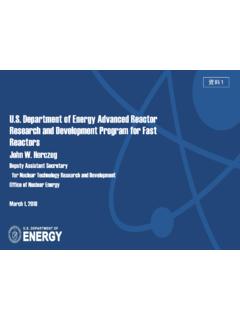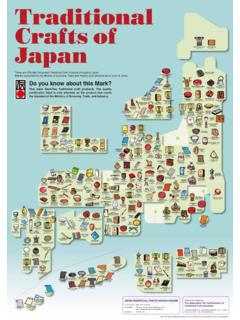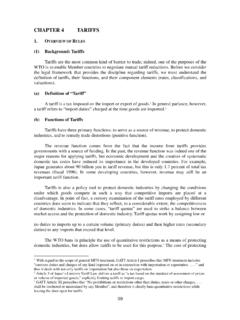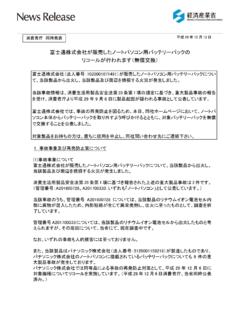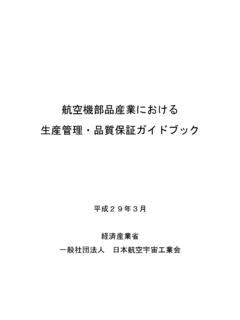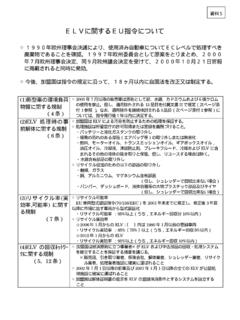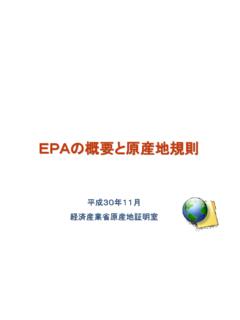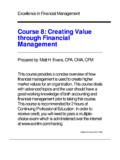Transcription of Chapter 4 Valuation Methods in Intellectual Asset …
1 210 Chapter 4 Valuation Methods in Intellectual Asset - based management evaluation finance ( supplemental discussion ) This Chapter explains one way of thinking for Valuation Methods in Intellectual Asset - based management evaluation finance . As described in the framework for Intellectual Asset - based management evaluation finance of Chapter 1, one characteristic of financing decisions based on Intellectual Asset evaluation is analysis of the relationship between the company s Intellectual assets and its business, and consideration of the value of Intellectual assets which is the basis of the actual situation balance sheet. In such a case of taking a financial goals perspective, it may be desirable to investigate economic Valuation as a Valuation method of Intellectual assets.
2 There are various ways of thinking about Intellectual Asset Valuation , but this Chapter takes up one technique of economic Valuation of Intellectual assets. 1. Basic Way of Thinking about Economic Value of Intellectual Assets An important point for the way of thinking at the foundation of understanding of economic Valuation of Intellectual assetsis the relationship between Intellectual assets which become the business core and other Intellectual assets (human assets, organizational assets, relationship assets). For example, the basic way of thinking is that if technical abilities, brands, sales abilities, etc. can be considered the foundation of its business earnings, then the value of a business utilizing these is created in the process of mutual interaction between its core Intellectual assets such as patents and know-how with other Intellectual assets (human assets, organizational assets, relationship assets) (Figure 4-1).
3 211 Figure 4-1 Process Creating Business Value ( Chapter 1, Figure 1-16 re-exhibit) Organizational assetsRelationship assetsChain of interaction between Intellectual assetsTechnology(patentrights)Brand(trad emark rights)Overall technology&sales(know-how, etc.)Human assetsBusiness valueBusiness valueBusiness valueFuture cash flow Sales expected Orders expected Cost reductionexpected management costs expected Earnings powerChain of interaction betweenintellectual assetsChain of interaction between Intellectual assetsBusiness core(1 example) For example, if sales come about through a combination of customer relationships and superior technology, then in order to achieve continual sales, a sales manual and service process which further raise customer satisfaction (other elements of Intellectual assets) become required. These interact and earnings are continually created, with the result that business value can be recognized.
4 2. Relationship between Intellectual Assets and Intellectual Property Rights In Intellectual Asset Valuation , the value of Intellectual property rights such as patent rights is as described in Chapter 1. Intellectual property rights have the characteristics of legal rights, and registration also prepares requirements for perfection against third parties, thus those rights may be a source of earnings. Furthermore, if business based on such Intellectual property rights is achieved, then calculating economic value with Intellectual property rights as the starting point may be one option relatively easy to approach, compared to other Intellectual assets. Even in such a case, one must investigate the business prospects and Asset characteristics of Intellectual property rights, while considering the relationship with and importance of other assets which become required in the process whereby Intellectual property rights create business value (Figure 4-2).
5 Below, we explain a Valuation method for the case of setting Intellectual property rights as the starting point. 212 Figure 4-2 Relationship between Intellectual Assets and Intellectual Property Rights ( Chapter 1, Figure 1-18 re-exhibit) In tellectu al property rightsExamp les: Patent rights, utility mod el rights, copyrights, Intellectual propertyExamples: Brands, business secrets, know-how, etc.(also including knowledge, research data, customer lists, p roposals, etc.)In tellectu al assetsExamples: Human assets, o rganizational abilities, man agementp ri n cipl es, p roc esses , s trategy, n etwork wi th c ustomers, s ki ll s, etc .In tan gible assetsExamples: Land lease rights, telephone subscription rights, : The intangible assets above signify all intangible business resources held by the enterprise, which is not the same meaning as intangible fixed assets recorded in the balance sheet.
6 3. Overview of Valuation Methods for Intellectual Property Rights For Methods of evaluating business value, there are various techniques depending on the issues and evaluation goals in the evaluation situation. In the same way, there are also various techniques for evaluation of Intellectual property rights. First of all, in a broad overview of Valuation Methods for Intellectual Asset rights, one can check the techniques as shown in Figure 4-3 below. 213 Figure4-3 SystemofValuationTechniquesforIntellectu alPropertyRights(bytransactionform&evalu ationgoal)SellingpriceProcurementpriceSe llerLicensorCollateralestablisherBuyerLi censeeCollateralrightsholderSellerLicens orCollateralestablisherBuyerLicenseeColl ateralrightsholderRightsexerciseLicenseL osscompen-sationforviolatingconductNoYes :PartyplanningexecutionLicenseePatentLaw Article102 RoyaltyexemptionmethodExecutionrightsubj ecttotransaction,notrightitselfExecutorC ontributionapproachmethod(Self-execution )Non-executorCostapproachLicenseGrantofe xecutionrightNoYes.
7 PartyplanningexecutionLicenseeContributi onapproachmethod(Othercompanyexecutes)Ro yaltyexemptionmethodBusinesspurchaseBusi nesstransferNo(establishpledgeright)No(e stablishpledgeright)Yes(mortgagebytransf er)Yes(mortgagebytransfer)CostapproachPr obabilityapproachIfdoingtechnicalevaluat ion,bymodelofevaluationbyscoringContribu tionapproach(3rdpartyexecution)Royaltyex emptionmethodPatentrightvaluationtakesaf ormsimilartobusinessvaluation, , :FinancialinstitutionMakeliquidM&AYesYes PartyreceivingtransferCostapproachMarket approachRealoptionmethodCollateralestabl isherContributionapproachmethod(Self-exe cution)Royaltyexemptionmethod:Partyplann ingexecutionCollateralFinancing,leaseDis posalbysaleYesYesIntellectualpropertyuse rEconomicvaluationmethodRemarksPartyplan ningexecutionBuyerContributionapproachme thod(Self-execution)DistributionSale/pur chaseCategoryFormGoalofevaluationTransfe rrightitselfTransferexecutionrightStandp ointNote:Contributionapproach, (November2007,MinistryofEconomy,Tradeand Industry;IntellectualPropertyPolicyOffic e)214In the case of Intellectual property rights, the evaluation technique differs depending on various factors: form of transaction (sale/purchase, license, M&A, etc.)
8 , whether the evaluation was from the seller s perspective or the buyer s perspective, etc. It also differs according to the evaluation s goal (sale, grant execution rights, business transfer, etc.). In the practical situation of financing goals, the contribution approach method or relief from royalty method appear to be widely adopted for many cases. The contribution approach is a way of thinking which estimates the cash flow obtained if the products which used that patent are developed and sold, and considers the contribution of that patent in order to assign a value to the patent rights equal to the discounted present value. For example, in a situation establishing a technology business which utilized patent rights, if one tries to obtain the value of technical Intellectual assets and value of patent rights in that business, as shown in the schematic diagram of Figure 4-4, this method does a factor analysis for the contributions of technical Intellectual assets and Intellectual property in overall business value, and estimates their values.
9 In short, as an assumption for calculating the economic values of Intellectual assets and Intellectual property, this approach first calculates the present value of the business itself which utilizes that technology and Intellectual property. Next, calculate the technology contribution portion of the value of the entire business. Next, calculate the contribution portion1of Intellectual property in technology. Figure 4-4 Valuation of Intellectual Property by Contribution Approach Portion of contribution by Intellectual assetsPortion of contribution by Intellectual propertyOverall business valuePortion contributed by non- Intellectual assetsPortion n ot contributed by Intellectual propertyPortion contributed by Intellectual property righ ts1 Strictly speaking, there is also the method of calculating the net present value of Intellectual property: Take the value of these Intellectual property rights as the value of maximum contribution portion of Intellectual property rights, and moreover, estimate the risk factors of dependence on incompleteness of each technical or Intellectual property factor element, and deduct this from the maximum value of the Intellectual property as a portion of technology.
10 215 One more alternative evaluation method is the relief from royalty method. The relief from royalty method is positioned as a simple method which considers practical application aspects, though following the basic way of thinking of the contribution approach described above. This evaluation technique does not directly estimate contribution of Intellectual property in business , but is considered one way of thinking which is a more simple and rational method of valuing Intellectual assets. In addition to Valuation of technology and patents, this useful method can also be applied to Valuation of brands and trademarks, thus the explanation below focuses on the relief from royalty method. 4. Relief from Royalty Method (1) Outline of Relief from Royalty Method As mentioned above, though Intellectual property Valuation by the relief from royalty method, follows the way of thinking of the contribution approach method for Intellectual property as described above, it is positioned as a simple method which considers practical application aspects.
